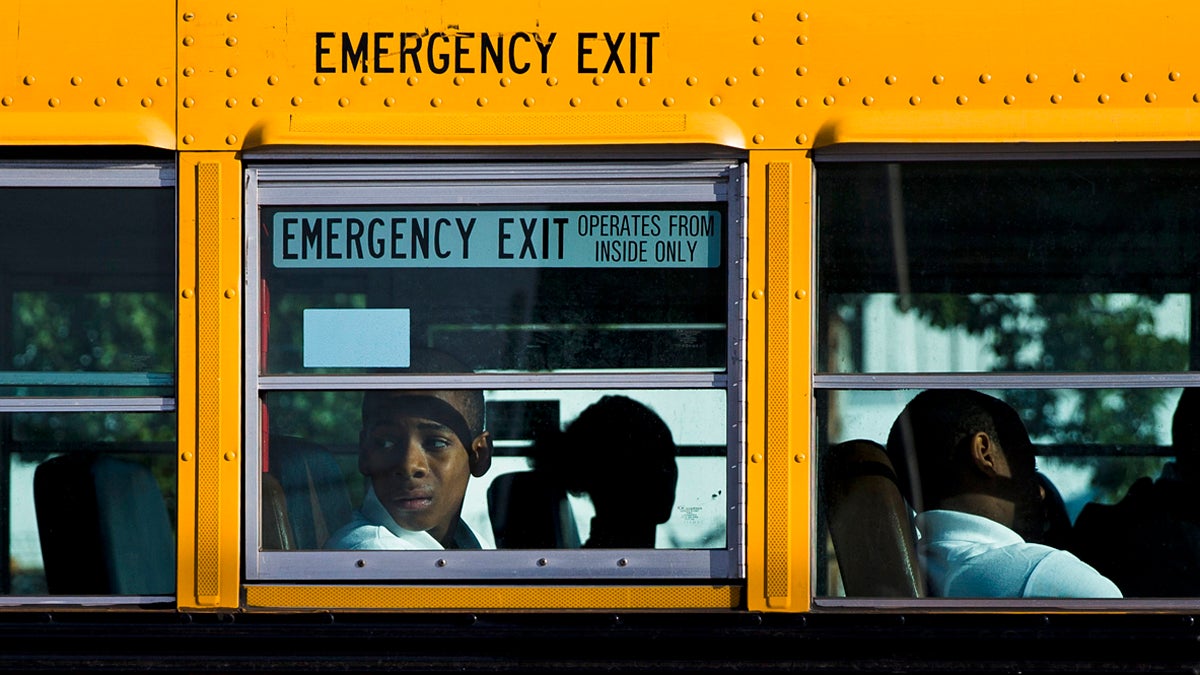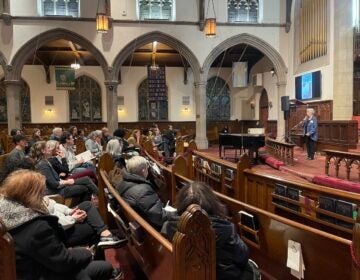How much does Pennsylvania spend on public schools, and how are costs shared?
Listen
Students arrive on the first day of school in Philadelphia. The city opened three new public high schools in an effort to show the troubled district is still trying to innovate despite the specter of massive layoffs. (AP Photo/Matt Rourke)
Pennsylvania’s system for distributing its state education aid has been rated by some surveys as one of the most regressive in the nation. Multiple Choices podcasts explore the history, complexities and controversies of public education funding in Pennsylvania.
First in an occasional series of podcasts and web “explainers.” To listen to the podcast, click the audio player above.
Q. How much does Pennsylvania spend on K-12 public education compared to other states?
In 2012, Pennsylvania spent $26.5 billion on K-12 education. Only five other states — California, New York, Texas, Illinois, and New Jersey— spent more.
On a per-student basis, Pennsylvania ranked 13th among the states. In 2012, Pennsylvania spent $13,653 per student compared to a national average of $11,735. Vermont came out on top with $18,882 per student and Utah ranked last with $6,688 per student.
Q. Where does the money come from?
Pennsylvania’s K-12 education system is funded through a combination of local (53 percent), state (36 percent), and federal (11 percent) sources.
Pennsylvania stands out because that state percentage of overall education funding, as opposed to local sources, is relatively small.
In 2012, Pennsylvania ranked 44th in the percentage share of education costs covered by the state. Its 36 percent contribution rate compares to a national average of 45 percent.
Most state funding comes through three budget line items: basic education aid, special education, and transportation.
Basic education aid, by far the largest chunk of the state education contribution ($5.5 billion in 2013-14), is allocated in an unpredictable manner, influenced heavily by past aid amounts and political arrangements that often benefit only selected districts.
Unlike most other states, Pennsylvania does not regularly adjust state aid to account for changes in enrollment, local wealth, numbers of English language learners, or other district and student characteristics.
Q. What is state education aid spent on?
The Pennsylvania Department of Education spends $10 billion each year on public school support.
Again, basic education aid makes up the largest chunk of this budget by far, at $5.5 billion. The next top four budget items are: school employees’ retirement ($1.2 billion); special education ($1 billion); transportation ($550 million, not including charter and students in approved private schools); and school employees’ Social Security ($500 million).
Q. How equitably is public education funding distributed among districts, compared to other states?
Pennsylvania’s system for distributing its state education aid has been rated by some surveys as one of the most regressive in the nation.
In Education Week’s 2012-13 Quality Counts report, Pennsylvania ranked towards the bottom on every measure of funding equity.
A 2014 Associated Press analysis of Pennsylvania districts found that districts in the top fifth for wealth, based on average resident income, are spending $4,000 more per student this year than those in the bottom fifth.
These poor ratings for equity could stem from several factors.
Due to the relatively low percentage of state contribution, school districts rely more on local tax revenues than in many states, and local districts’ wealth varies widely.
Most states distribute state aid to districts according to a funding formula that takes into account changes in enrollment, local district wealth, and other factors.
Pennsylvania does not have a predictable funding formula based on actual enrollment.
Instead, it distributes state aid based on a historical baseline and allocations from the previous year. The state’s “hold harmless” policy means that a district will get at least as much state aid as it got the year before, even if its enrollment declines.
In addition, legislators often target special grants to individual districts.
Critics of Pennsylvania’s performance say its reliance on property taxes to pay for school costs contributes to inequities. They say relying on such local taxes tends to lock in inequalities between affluent districts with strong tax bases, and districts with less robust ones. The struggling districts include some in cities, highly residential inner-ring suburbs and rural areas.
Pennsylvania law sharply reduces taxes on productive farmland. In some rural areas like Octorara School District, officials say these laws have forced them to levy much higher property taxes on homes and businesses than other districts.
Finally, Pennsylvania law ensures that every district receives some amount of state aid, even the state’s wealthiest systems. Combined with the “hold harmless” provision, this factors into the equity picture.
It means that affluent districts never get less than the year before – even in years when the overall state allocation falls well short of a general rise in school expenses. In such years, districts that have less local wealth to offset a drop in state aid tend tend to fall further behind.
Pennsylvania also stands out due to inequalities in spending tied to the race of students. An analysis by the Center for American Progress found that on average black students in Pennsylvania receive 89 percent of the funding that white students receive, less than in any other state except Nebraska and New Hampshire; Hispanic students receive just 85 percent.
While the the center’s study did not control for poverty, a study by a data analyst with POWER, an interfaith organization in Philadelphia, found that Pennsylvania’s school district funding is still racially skewed after controlling for poverty.

Students arrive on the first day of school in Philadelphia. (AP Photo/Matt Rourke)
What about Philadelphia?
The Philadelphia School District has particular challenges in obtaining local funds. Instead of an elected or appointed local school board, the state-created School Reform Commission controls the District. Unlike the elected school boards in every other district, the SRC (with three state-appointed and two city-appointed members) lacks the authority to levy local taxes.
Local funding comes through the mayor and City Council. The lack of direct control these elected officials have over school district spending can make them decidedly reluctant to approve higher taxes or fees to support the school sytem.
Philadelphia has other complications. Because Philadelphia is both a city and a county, it must fully fund its court and police costs. In other areas of the state, these services get funded through county government, meaning costs are shared by the more and less affluent parts of a county.
About 55 percent of Philadelphia’s property tax revenue currently goes to the school district, far from enough to fund the system’s needs. To raise more school funds, the city has cobbled together a mix of levies on business, use and occupancy, unearned income, liquor-by-the-drink, sales receipts, and cigarettes. This year, local sources accounted for 46 percent of the District’s $2.6 billion budget.
Are there any other districts with unusual structures?
In 2012, the state used a new law, HB 1307, to classify four school districts— York City, Harrisburg City, Duquesne City, and Chester-Upland— as “financially distressed” and put them under state control.
In these districts, the state appoints a chief recovery officer who takes over the authority of the school board. However, the CRO cannot levy local taxes like the school board because of a 1936 state Supreme Court ruling that only elected bodies can do so.
Allison Welton of the Notebook contributed reporting to this article.
In the Multiple Choices podcast, Keystone Crossroads senior education writer Kevin McCorry joins with Paul Socolar, publisher and editor of the Public School Notebook, and Notebook contributing editor Dale Mezzacappa to explain and explore the history, complexities and controversies of public education funding in Pennsylvania.
Look for new installments of Multiple Choices every week for the rest of the spring, as the General Assembly reviews Gov. Wolf’s ambitious school funding and tax plan.
WHYY is your source for fact-based, in-depth journalism and information. As a nonprofit organization, we rely on financial support from readers like you. Please give today.






